#ecommerce multi vendor
Explore tagged Tumblr posts
Text

VendorElite’s multichannel selling software transforms inventory management by centralizing and automating inventory tracking across multiple sales channels. This ensures real-time synchronization of stock levels, reducing the risk of overselling and stockouts. With VendorElite, businesses can efficiently manage orders, maintain accurate inventory records, and optimize stock levels to meet demand across various platforms, ultimately enhancing operational efficiency and customer satisfaction.
#Free Multi-Vendor Software for eCommerce#multichannelsellingsoftware#bestecommercesoftware#freeshippingsoftware#ohio#usa#canada#vendorelite#sellingproducts#ecommerceshop#newyork
1 note
·
View note
Text
Multi Vendor Marketplace Development: Top Features, Key Challenges, and Proven Solutions

Online shopping has changed a lot in recent years. Customers now expect more options, better pricing, and quick deliveries—all in one place. This is where multi vendor marketplace development comes in.
A multi vendor marketplace allows many sellers to showcase and sell their products on a single platform. Platforms like Amazon, Flipkart, and Etsy have made this model extremely popular. But building your own marketplace is not just about copying big names. It involves careful planning, smart design, and reliable technology.
In this blog, you’ll discover the core features of a good multi vendor eCommerce platform, the challenges involved, and proven solutions to build and grow your own successful online marketplace.
Essential Features of a Multi Vendor Marketplace
Creating a powerful marketplace requires a strong foundation. Below are the most important features that every multi-vendor platform must have.
1. Easy Vendor Onboarding
Getting vendors to sign up should be fast and hassle-free. Your platform should allow vendors to register, upload documents, and start selling with minimal steps. A clear dashboard helps vendors manage their profile, products, and orders easily.
2. Vendor Dashboards with Analytics
Each seller should get their own dashboard. This should include tools to upload products, view sales performance, check inventory levels, and respond to customer messages. Real-time data and reports help vendors improve their performance.
3. Flexible Product Catalog System
A strong product catalog lets vendors add products under categories and use filters, tags, and descriptions. High-quality images and SEO-friendly product titles also improve visibility on search engines.
4. Customer Reviews and Ratings
Reviews build trust. Buyers should be able to leave ratings and feedback for both products and sellers. This helps new customers make informed decisions and encourages vendors to offer better service.
5. Smart Search and Filtering Options
Shoppers should be able to find what they need quickly. Features like advanced filters, keyword search, auto-suggestions, and personalized recommendations make browsing smoother and faster.
6. Secure Payments with Split System
Payment systems must be secure and flexible. The platform should automatically split payments between vendors and the admin. Gateways like Stripe, Razorpay, and PayPal are commonly used in such systems.
7. Order Management and Tracking
The platform should manage multi-seller orders smoothly. It must support order splitting, vendor-specific shipping, status updates, and tracking links for buyers. Vendors should get notified of every new order.
8. Mobile Optimization and App Support
Most buyers shop on mobile today. Your multi vendor eCommerce website should be fully responsive. Consider building mobile apps for Android and iOS to reach a wider audience.
Common Challenges in Multi Vendor Marketplace Development
Developing a marketplace isn’t as simple as launching a basic online store. You’ll face several challenges along the way.
1. Complex Platform Architecture
A multi-vendor marketplace handles many users at once—buyers, sellers, admins, and delivery partners. Balancing this load requires a solid backend and scalable infrastructure.
2. Vendor Management at Scale
Different vendors mean different business styles. Some may ship fast, others may delay. Some may list hundreds of products, others just ten. Standardizing quality and performance while allowing vendor flexibility is a big challenge.
3. Dispute Resolution and Refunds
Conflicts happen. Maybe a buyer didn’t receive the right item or a product was damaged. You’ll need a proper dispute management system that supports refunds, returns, and escalations.
4. SEO and Duplicate Content Issues
If many vendors sell similar products, you may face duplicate content issues. This can hurt your ranking on Google. Smart content structure, canonical tags, and product schema help improve SEO performance.
5. Data Security and Compliance
Handling customer data is a serious responsibility. Your platform must comply with laws like GDPR. Add SSL encryption, token-based login, and secure payment protocols to protect all user data.
Smart Solutions to Build a Successful Marketplace
Every challenge comes with a solution. Here’s how you can overcome the hurdles and build a reliable and scalable marketplace.
1. Use Modular Architecture
Instead of building everything as one block, break down your platform into smaller parts. This modular approach helps improve performance and allows future updates without crashing the entire system.
2. Choose Cloud Hosting
Platforms like AWS, Google Cloud, or Azure allow your marketplace to handle large traffic without breaking down. Cloud hosting also offers better security and data backup options.
3. Develop Vendor Guidelines and Policies
Create clear rules for vendors. Explain how listings should look, how fast items must be shipped, and how disputes are resolved. Set SLAs (Service Level Agreements) and ensure every vendor agrees to follow them.
4. Regular SEO Updates
Keep your SEO strategy updated. Add meta descriptions, use unique product content, and implement rich snippets. You can also run content audits to remove duplicate or outdated pages.
5. Partner with the Right Development Company
This is one of the most important steps. You need an experienced tech team that understands marketplace architecture, security, UI/UX, and ongoing maintenance.
Why Choose Idiosys Tech for Your Multi Vendor Marketplace Development
If you’re looking to build or scale your multi vendor eCommerce platform, you need expert support. Idiosys Tech is a top-rated eCommerce website development company in Kolkata that specializes in Multi Vendor Marketplace Development.
Here’s why we stand out:
• Custom development using the latest technologies • Fully responsive design with SEO optimization • Native app development for Android and iOS • Experience with payment integration, order systems, and logistics • Excellent post-launch support and maintenance
We understand the Indian market as well as global trends. Whether you're launching a niche marketplace or a large-scale platform, we offer the expertise you need.
Future Trends in Multi Vendor Marketplace Platforms
To stay ahead of the curve, watch out for these trends:
1. AI and Personalization
Artificial intelligence helps show the right products to the right users. Platforms are using machine learning to improve recommendations and boost sales.
2. Voice Search
Voice-enabled shopping is rising. Marketplaces are starting to add voice support to help users search products more easily.
3. Blockchain in eCommerce
Blockchain brings transparency to transactions and supply chains. It's becoming popular in high-value product marketplaces.
4. Headless Commerce
This approach lets you manage the backend separately from the front-end. It gives more control over design, personalization, and performance.
5. Green Logistics
More customers care about eco-friendly delivery and ethical sourcing. Marketplaces are adapting by using recyclable packaging and working with green logistics providers.
Conclusion: Launch and Scale with Confidence
Multi Vendor Marketplace Development is no longer optional—it’s the future of eCommerce. Businesses that embrace this model early stand to gain the most. But building a successful platform isn’t just about having the idea. You need the right features, the right team, and a solid strategy.
From onboarding vendors to managing orders, from SEO to secure payments—every piece must fit together smoothly. The good news? You don’t have to do it alone.
Idiosys Tech, a trusted eCommerce website design company in Kolkata, can guide you through the entire journey. Whether you're just starting or planning to scale, they offer the skills and support needed to make your marketplace thrive.
Ready to build your marketplace? Contact us today and start your journey toward eCommerce success.
-------------------------------------------------------------
What is the difference between a multi-vendor marketplace and a traditional eCommerce site?
A traditional eCommerce site sells products from a single seller or brand, while a multi-vendor marketplace allows multiple sellers to list and sell their products through a single platform.
Can I monetize a multi-vendor marketplace without selling products myself?
Yes. You can earn through commissions, listing fees, subscription plans for vendors, sponsored products, or ad placements—without managing inventory yourself.
Is it necessary to have a mobile app for my marketplace?
While not required at launch, having a mobile app boosts engagement, especially in mobile-first markets. Users prefer apps for convenience and speed.
Is it possible to run a local or hyperlocal multi-vendor platform?
Absolutely. Many startups launch city-based food, grocery, or service marketplaces. You can expand regionally or nationally once operations stabilize.
What is the role of a content management system (CMS) in a marketplace?
A CMS helps you manage blogs, banners, promotional pages, vendor guides, and static content without technical help—keeping your platform fresh and SEO-friendly.
Can AI and automation help in managing a marketplace?
Yes. AI can assist with product recommendations, fraud detection, customer service chatbots, and automated reporting—boosting efficiency and user satisfaction.
-------------------------------------------------------------
You May Also Read
Custom Quick Commerce Platform Development: Key Features, Challenges, and Proven Solutions
How to Develop a Custom E-Commerce Marketplace in 2024
The Voice Revolution: It's Time to Speak Up in E-commerce
Shopify vs. Custom Ecommerce: Deciding Your Digital Destiny in 2024
#Multi vendor eCommerce platform#Multi vendor marketplace platform#Multi vendor marketplace#Multi Vendor Marketplace Development
0 notes
Text
How Much Does It Cost to Develop a Marketplace App?
Marketplace apps are changing the way people buy and sell online. If you're thinking about marketplace mobile app development, you might be wondering—how much does it really cost- The answer depends on several factors, like features, technology, and the team you hire. Let’s break it down in simple terms.
Key Factors That Affect the Cost
1. Features and Functionality
The more features you add, the higher the cost. Here are some must-have features:
User Registration & Profiles – Let users sign up easily, with social media login options.
Product Listings & Search – Users should find what they need quickly with filters and categories.
Order Management – A smooth cart, checkout, and order tracking system.
Payment Integration – Secure payment gateways like PayPal, Stripe, and Apple Pay.
Multi-Vendor Support – Sellers need their own profiles, dashboards, and commission settings.
Admin Panel – A control panel to manage users, orders, and reports.
Want to stand out? Advanced features like AI recommendations, AR previews, and blockchain security will cost extra.
2. Platform and Technology Stack
Are you building an app for iOS, Android, or both? Native apps (Swift for iOS, Kotlin for Android) tend to be more expensive than hybrid apps (Flutter, React Native). The backend is equally important, using technologies like Node.js, Laravel, or Django with cloud-based storage.
3. Development Approach
How you build your marketplace also affects the budget:
Custom Development: Offers the most flexibility but is the most expensive.
Marketplace App Builders: Faster and more affordable, but with some limitations.
Pre-built Solutions: Great for startups who want to launch quickly on a budget.
4. Development Team and Location
Who you hire matters. Developers in the US/UK charge around $100-$150 per hour, while experienced developers in Asia charge around $25-$50 per hour.
How Much Will It Cost?
Here’s a rough estimate:
Basic Marketplace App: $15,000 - $30,000
Mid-Level Multi-Vendor App: $40,000 - $80,000
Advanced Custom Marketplace: $100,000+
Final Thoughts
An eCommerce Marketplace App Builder can help you develop an app faster. The right approach depends on your budget, business goals, and long-term vision. Investing wisely ensures your marketplace app is both successful and profitable.
#marketplace mobile app builder#Marketplace mobile app creator#eCommerce Marketplace App Builder#Marketplace Multi-Vendor app
0 notes
Text
#eCommerce Website Development Service in noida#WooCommerce Store Development Service in noida#Shopify Store Development Service in noida#Custom Store Development Service in noida#Multi Vendor eCommerce Development Service in noida#noida#nxlogy
0 notes
Text
I will design a high performance woocommerce multi vendor ecommerce site with dokan pro
With extensive experience in eCommerce and WooCommerce, I understand the critical elements needed to build a successful multi-vendor marketplace. My expertise with Dokan Pro and WCFM ensures a robust, feature-rich platform tailored to your unique needs.
FIND OUT MORE:
https://www.fiverr.com/s/xXjE5AZ
0 notes
Text
#Web Designing Services#Custom Website Designing#Website Maintenance Services#Landing Page Web Designing#Portfolio Website Designing#Blog & News Website Designing#Dynamic Website Designing#Web Application Development#eCommerce Web Development#Mobile App Development#Custom CMS Development#CMS Web Development#Multi Vendor Ecommerce#Business Branding Services#Brand Development & Strategy#Brochure Designing#Logo and Brand Designing#Company Profile Design#Video Production Services#Market Place Cataloging#Digital Marketing Services#Search Engine Optimization#Social Media Marketing#PPC Ads Services#Web Page Speed Optimization#Content Marketing Services#Google My Business Promotion
0 notes
Text
SHEconomy Empowering Women Entrepreneurs
In recent years there has been a rise in the number of female entrepreneurs all over the world. Even the brands that empower women are not just making a statement, they're making a name for themselves. SHEconomy is a brand that helps women to sell and market their goods and services. SHEconomy has a vibrant community created especially for women entrepreneurs. This platform provides women entrepreneurs the opportunity to sell their products and helps them connect with customers at a deeper level. So, in this blog, we will look at the rise of women entrepreneurs in India.
What is SHEconomy?
SHEconomy is an online marketplace where women entrepreneurs have the opportunity to showcase their products. It provides many tools and resources for women in their businesses. By providing them adequate resources SHEconomy ensures that women have the opportunity to prosper in the competitive entrepreneurial world.
Features of Sheconomy that are beneficial for small businesses
User-Friendly interface
The platform has a user-friendly interface. Therefore it is easy for anyone to start an online store, regardless of technical skills.
Comprehensive tools
SHEconomy provides many tools such as inventory management, payment processing, and shipping solutions, making it a one-stop solution for all e-commerce needs.
Marketing Support
With integrated marketing tools, SHEconomy helps businesses reach global audiences easily through various digital marketing resources such as social media integration, email marketing, and more.
Community Support
One of the major features of the SHEconomy app is community support. It is through this community that women entrepreneurs can connect, share experiences, and support each other.
SHEconomy Dashboard: A Comprehensive Overview
The SHEconomy Dashboard provides a seamless user-friendly experience. It has a clean and organized layout that helps users to easily navigate through different sections, making it simple to manage their online stores efficiently.
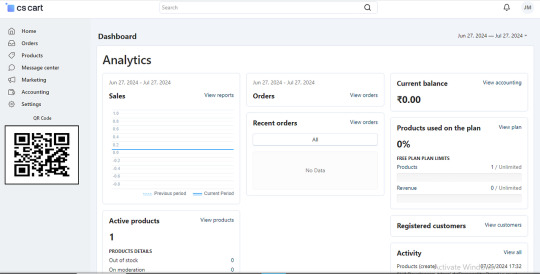
Key Features of the Dashboard
Analytics and Insights
It provides detailed Analytics and insights that help users to track their sales and monitor customer behaviour. It will also help them to understand market trends.
Order Management
Managing orders is easy with the SHEconomy dashboard. Users can view and process orders, track shipments, and handle returns all from a single interface, ensuring smooth operations.
Product Management
Adding, editing, and managing products is straightforward. The dashboard allows users to organize their inventory, set pricing, and manage stock levels effortlessly.
Marketing Tools
The dashboard offers several marketing tools such as email marketing, social media integration, and promotional campaigns. Thus helping users to effectively sell their products and reach a wider audience.
Community Feature on SHEconomy App to Help Small Businesses

Key Benefits of the Community Feature
Networking Opportunities
It is through various networking events or online forums, that women entrepreneurs can connect with fellow entrepreneurs and build a strong community. Various tools and resources are provided by SHEconomy that can be useful for them to build a strong community.
Empowering Small Businesses through Community Feature
Small businesses play a vital role in the progress of an economy. This success completely depends on well-researched marketing strategies. However, due to limited resources small businesses need to employ other techniques for significant reach and engagement opportunities. This is where the community Feature on Sheconomy comes into action. It helps small business owners to effectively engage with their target audience and also helps them to cultivate a relationship with them. Thus, by using the community Feature on Sheconomy female entrepreneurs can connect with a global audience. Additionally, SHEconomy partners with its vendors, offering spotlight features to highlight and promote them. This partnership will help them to increase visibility and create a strong support system for small businesses, ensuring they succeed in the competitive entrepreneurial world.
Support and Encouragement
Building a business can be a tough task but the SHEconomy community will help you to get a support system that will offer encouragement and advice.
Conclusion
In the ever-changing landscape of the entrepreneurial world, SHEconomy is a ray of empowerment for women worldwide. SHEconomy is one of the best platforms for women to showcase their talents and carve a name for themselves in business. With free listings and women-led policies, through its various tools, This platform promotes Inclusivity and collaboration among female entrepreneurs and is showing the world that women too are capable of taking up leadership roles in the business world.
#women coming together#women supporting women#ecommerce platform for women#women entrepreneurs#ecommerce#entrepreneur#businessgrowth#free platform for women entrepreneurs#multi vendor marketplace#multivendor ecommerce platform#free alternatives to shopify
0 notes
Text
Integrating E-Commerce Solutions across Websites and Apps for Multi-Platform Selling

In digital age, e-commerce has become an integral part of the retail industry. With the rapid growth of online shopping, businesses are constantly seeking ways to expand their reach and maximize their sales potential. One effective strategy that has emerged is multi-platform selling, which involves integrating e-commerce solutions across websites and apps to create a seamless shopping experience for customers.
Without a doubt, selling across various platforms is a game changer in the realm of custom eCommerce development, with the potential to propel any organization to new heights. This blog will look at all aspects of multi-platform selling and how it affects the modern eCommerce business scene. Let us get started.
eCommerce Evolution: A New Era of Online Selling
Welcome to the new era of online selling! With the ever-growing popularity of e-commerce, businesses are constantly seeking ways to expand their reach and increase their sales. One such method that has gained significant traction is multi-platform selling, which involves integrating e-commerce solutions across websites and apps.
However, because consumer behaviours and market demands change so quickly, an all-in-one or single eCommerce strategy is insufficient for long-term success. This is where multi-platform selling provides numerous chances for firms looking to increase engagement and diversify their reach.
What Does Multi-Platform Selling Mean?
Multi-platform selling refers to the practice of selling products or services through multiple online channels simultaneously. This approach allows businesses to reach a wider audience and cater to customers' preferences across various platforms, including websites, mobile apps, social media platforms, and marketplaces. By offering a consistent shopping experience across different channels, businesses can enhance customer engagement, increase brand visibility, and boost sales.
Whether you run a little business or a large corporation, if you carefully position your company on these platforms, you will meet all of your customers' expectations by providing a convenient purchasing experience. However, managing sales across several channels is not as simple as it appears; a custom eCommerce development solution is required to optimize the process.
Major Perks of Multi-Platform Selling
There are several significant perks associated with multi-platform selling. Let's take a closer look at some of the major advantages that businesses can enjoy:
1. Expanded Reach: By leveraging multiple platforms, businesses can tap into a larger customer base and target diverse demographics. This broadens their reach and increases the chances of attracting new customers.
2. Enhanced Customer Experience: Multi-platform selling enables businesses to provide a seamless and consistent shopping experience across various channels. Customers can browse products, make purchases, and access support services conveniently, regardless of the platform they prefer.
3. Increased Sales Opportunities: With multiple channels at their disposal, businesses have more opportunities to showcase their products and services and convert leads into sales. Each platform serves as an additional sales channel, increasing the chances of generating revenue.
4. Improved Brand Visibility: Businesses may increase brand awareness and familiarity by maintaining a presence across many media. Consistent branding across channels promotes client trust and loyalty.
5. Better Data Insights: Multi-platform selling allows businesses to gather data from different sources, providing valuable insights into customer behaviour, preferences, and trends. This data can be used to optimize marketing strategies, personalize customer experiences, and drive informed business decisions.
Other key benefits of multi-platform selling include:
Improved conversion rate
Better customer loyalty.
Improved inventory transparency.
Improved customer segmentation.
Mobile commerce trend capitalization
Best Platforms for Multi-Channel eCommerce Business
1. Shopify: Shopify offers a comprehensive e-commerce platform that allows businesses to create and manage online stores. It provides seamless integration with various sales channels, including websites, mobile apps, social media platforms, and marketplaces.
2. Magento: Magento is a highly flexible and scalable e-commerce platform that caters to businesses of all sizes. It supports multi-channel selling by integrating with multiple platforms, enabling businesses to sell across websites, mobile apps, and marketplaces.
3. Etsy: If you want to sell antique, handcrafted, craft supplies, or other one-of-a-kind things online, Etsy is a great place to start. Users may easily access a wide range of product categories on this marketplace, including clothing, jewellery, tools, home, living, kids & babies, and entertainment.
4. Amazon Marketplace: As one of the largest online marketplaces, Amazon provides businesses with a vast customer base and global reach. Selling on Amazon Marketplace can significantly expand the visibility and sales potential of products.
5. eBay: eBay is another popular online marketplace that allows businesses to sell products to a wide range of customers. With its auction-style listings and fixed-price options, eBay offers flexibility for multi-channel selling.
6.Walmart Marketplace: Walmart is a frequently used marketplace that provides excellent prospects for online enterprises. This is a curated e-commerce portal. As a seller, you must meet specified requirements for providing excellent customer service.
7. Facebook Marketplace: This is Facebook's integrated platform that provides fantastic online selling choices to local sellers and small enterprises. This platform is simple to use and helps you promote your goods to a social media-savvy customer audience.
How to Set Up a Successful Multi-Platform Selling Strategy:
1. Identify Target Platforms:
Research and analyse the platforms that align with your target audience and business objectives. Consider factors such as platform popularity, user demographics, and integration capabilities.
2. Seamless Integration:
Select e-commerce platforms that offer robust integration capabilities with various channels. Ensure that your chosen platforms can synchronize product listings, inventory, pricing, and order management across all channels.
3. Consistent Branding:
Maintain consistent branding elements, such as logo, colors, and messaging, across all platforms. This creates a cohesive brand identity and fosters customer recognition and trust.
4. Optimize User Experience:
Provide a user-friendly and intuitive shopping experience on every platform. Optimize website and app performance, ensure mobile responsiveness, and streamline the checkout process to minimize friction and maximize conversions.
5. Data-Driven Decision Making:
Leverage analytics and data insights to monitor and measure the performance of each platform. Identify trends, customer preferences, and areas for improvement, and use this information to refine your multi-platform selling strategy.
6. Customer Support:
Offer consistent and responsive customer support across all platforms. Provide multiple channels for customer inquiries, such as live chat, email, and phone, to ensure a seamless support experience.
7. Cross-promotion:
Cross-promotion is a marketing strategy where two or more parties promote each other's products or services to their respective audiences. It's a mutually beneficial arrangement that can help increase brand exposure, reach new customers, and drive sales.
8. Privacy and Data Security:
- Manage all of your customers' data safely.
- Display all privacy policies to your customers to develop trust.
9. Focus on market trends.
- Keep up with the latest industry developments, platform updates, and client requests.
- Be prepared to change your business approach (if necessary) to stay ahead of the market.
Conclusion:
Multi-platform selling has become a crucial strategy for businesses aiming to thrive in the competitive e-commerce landscape. By integrating e-commerce solutions across websites and apps, businesses can expand their reach, enhance the customer experience, and boost sales. With the availability of various platforms, businesses can choose the ones that align with their target audience and business goals. By implementing a well-planned multi-platform selling strategy, businesses can establish a strong presence across multiple channels, drive customer engagement, increase brand visibility, and ultimately achieve success in the evolving world of e-commerce.
#Multi-Vendor E-Commerce Market Place Software#Best Multi-Channel Listing Software Solutions For Ecommerce Sellers#ECommerce Management Solution#ECommerce Product Management#Best ECommerce Software#Multi-Channel Selling Software#Shipping Software#Multi-Channel eCommerce Inventory Management Software#Product Listing Software#Multichannel Marketplace Software#Connect Infosoft#E-commerce website development#E-commerce website optimization#Mobile commerce optimization#Mobile commerce solutions#Multi-channel sales management
1 note
·
View note
Text
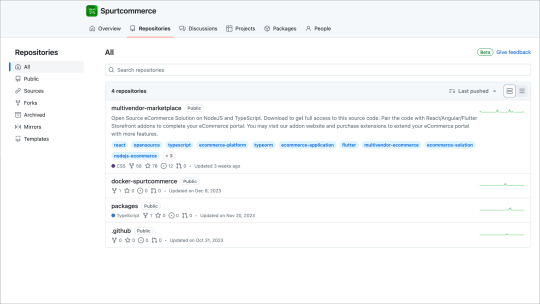
Dive into Spurtcommerce Multi-Vendor Repositories on #github Join the revolution of Online Marketplace Development in Latest Technology.
🔹 Multi-Vendor Capabilities: Develop an Online Marketplace with Multi-Vendor Capabilities. 🔹 Seamless Data Migration: Smoothly migrate your existing eCommerce Data into Spurtcommerce. 🔹 Scalable Architecture: Grow your marketplace without limits, adapting to your needs. 🔹 Customization Options: Tailor your marketplace to your brand's unique identity and vision.
0 notes
Text
You’re Premier Multi-Vendor Ecommerce Platform Accra
Discover a bustling hub of commerce in Accra with our Multi-Vendor Ecommerce Platform Accra. Connecting buyers and sellers seamlessly, it's the heartbeat of online shopping in Ghana's vibrant capital.
0 notes
Text

How to Build a Cutting-Edge Android & iOS Marketplace App: An AI-Powered Guide for 2025
Ready for market dominance? Build your custom, AI-integrated Android & iOS marketplace app with us. Start your journey now!
Boost your business with a cutting-edge Android & iOS marketplace app! Our AI-powered guide for 2025 details how custom marketplace solutions, cross-platform development, and AI integration create seamless, intelligent experiences for buyers and sellers, expanding your reach and competitiveness.
#shopify expert marketplace#marketplace app development#building a marketplace app#dev marketplace#marketplace website development#rapidapi hub#ecommerce marketplace development#marketplace developers#marketplace development platform#online marketplace software developers#marketplace software development#fiverr software development#online marketplace development#sharetribe developers#mirakl software#programmer marketplace#marketplace app development cost#marketplace for web developers#multi vendor ecommerce website development#custom marketplace development
0 notes
Text
Build Your Marketplace with a Multi-Vendor App Solution
Looking to launch a marketplace multi-vendor app- Our expert marketplace mobile app development services help businesses create scalable and feature-rich platforms for seamless vendor and customer management. With our eCommerce marketplace app builder, get advanced features like vendor dashboards, commission management, and secure transactions. Grow your business with a powerful marketplace solution designed for success.
0 notes
Text
#eCommerce Website Development Service#WooCommerce Store Development Service#Shopify Store Development Service#Custom Store Development Service#Multi Vendor eCommerce Development Service#noida#nxlogy
0 notes
Text
From Electronics and Clothing to Food and Pharmaceuticals, Ecommerce is Omnipresent.

In today’s world, it is nearly impossible to think about shopping without ecommerce. It has completely engulfed the entire retail industry. A futuristic retail business cannot afford to remain offline, especially after the pandemic when offline businesses were either forced to exit or face loss. Retail businesses turned to modern advanced technology and went online which not only kept them afloat but also brought sales and profit.
One can find almost all the desired products online on his ecommerce marketplace app. With just a few clicks or touches, a customer can enter into the world of online shopping where multiple vendors display their digital catalogue and place orders smoothly. All this has been made possible due to the power of multi vendor marketplace software that is delivering multiple benefits to the stakeholders involved in online shopping.
Multiple vendors on the same platform: Instead of having dedicated ecommerce software for each vendor to display their products, online marketplace software allows them to use one single platform to sell their items. Amazon and Flipkart are the best examples. A new vendor on the platform doesn’t have to invest heavily in marketing as he gets an already built customer base in the marketplace.
A variety of products: Due to the availability of multiple vendors on a single platform, the customers don’t have to jump from one platform to another in order to find the best products at the best price. They can find everything on the same platform thereby, reducing their efforts and saving their precious time.
Super fast delivery: Timely delivery has become a major factor in determining the success of any online business. Failing to deliver the product in the stipulated time, spoils the shopping experience of the customer. Keeping note of this, the multi vendor marketplace software has brought end-to-end automation in the entire ordering and delivery process. For instance, the delivery agent can find the optimized delivery route on their driver app in order to contribute to achieving quick commerce.
The ease of uploading items: With the help of the vendor’s dedicated merchant app, the sellers can upload items in bulk ranging from electronics and clothes to food and pharmaceuticals in just a click or touch. This makes the work of sellers easy. Also, the ease of product upload helps the customers in finding a variety of items on a marketplace.
In the eCommerce Market, the number of users is expected to amount to 2.5bn users by 2028. User penetration will be 29.7% in 2023 and is expected to hit 34.1% by 2028. Going through the data above, it is evident that ecommerce is omnipresent and is going to exist for a long time. Thus, prudent businesses will be ones that will walk along with the advancing technology.
#quick commerce#q commerce#ecommerce marketplace#multi vendor ecommerce#multi vendor marketplace software#multi vendor marketplace#multi vendor ecommerce software
0 notes
Text
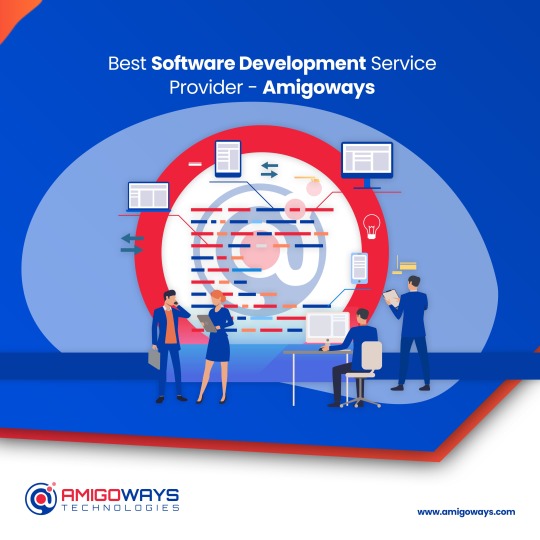
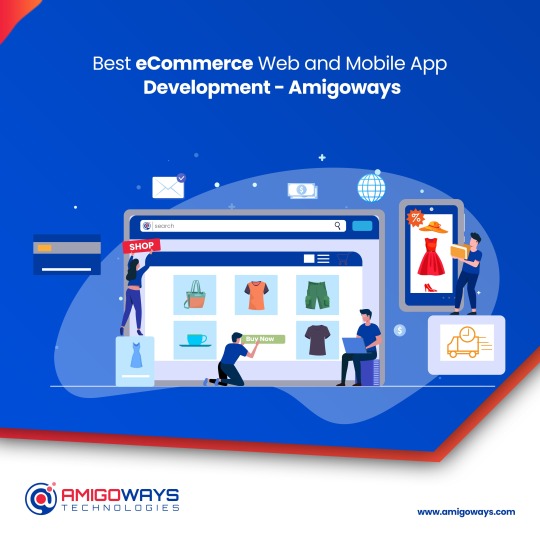
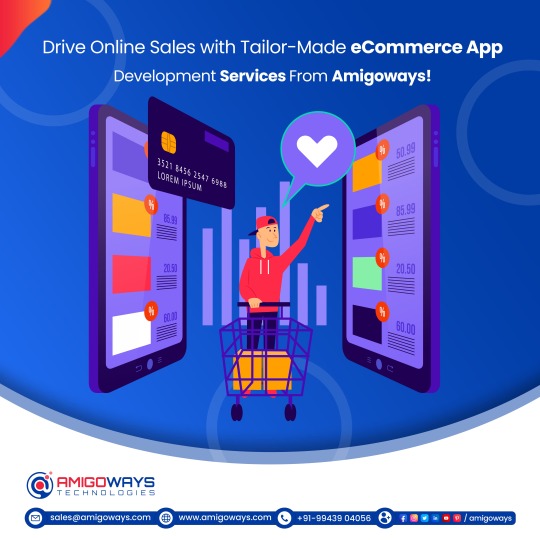
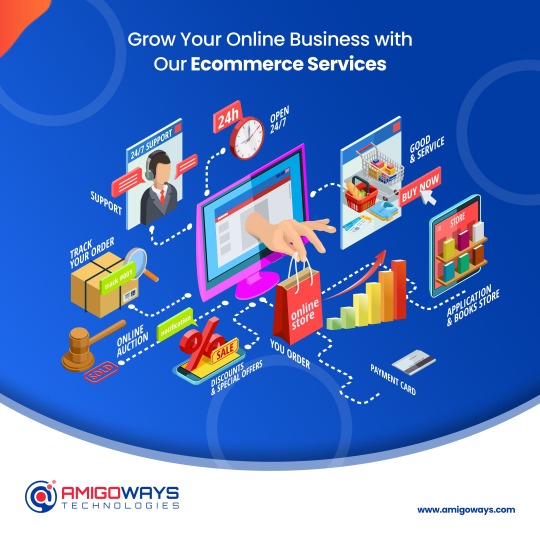
Top eCommerce Development In Tamil Nadu
Amigoways is one of the most trusted eCommerce development company in Madurai, We offer effective and successful eCommerce website & extension development for all types of B2B & B2C organizations. Amigoways is a team of well-trained, certified tech professionals who structure your venture with a business suite. Our multitude of services for your business upliftment on the business market.
Our eCommerce Development Services
Custom ECommerce Development
API Integration & Customization
Data Maintenance & Migration
ECommerce Audit & Optimisation
ECommerce Data Analytics
ECommerce Consulting
Business Intelligence
To know more about eCommerce development services Tap on - https://www.amigoways.com/ecommerce-development/
#ecommerce website development in madurai#Multi Vendor eCommerce Services in Tamil Nadu#top Multi Vendor eCommerce Services in Tamil Nadu#b2b ecommerce software solutions in madurai#multi vendor clone script madurai
0 notes
Text
The Benefits Of A Multi-Vendor Marketplace
The concept of a multivendor marketplace has been gaining popularity in the last few years. It is successfully bringing a revolution in the way consumers shop and vendors sell their products. This business model allows multiple sellers to offer their goods and services on a single platform, creating a diverse and dynamic shopping environment. One of the major examples of this model's success is SHEconomy. SHEconomy showcases the diverse entrepreneurial talents of women by providing them with various options for their growth. So, in this blog, we will look at the various benefits provided by the multi-vendor marketplace, with a specific focus on SHEconomy and its impact on female entrepreneurs.
Empowerment of Women Entrepreneurs

SHEconomy showcases the diverse entrepreneurial talents of women by providing them with various options for their growth. Starting from fashion to beauty to home decor, tech gadgets, to providing healthy lifestyle choices, women are gradually making their mark in every sphere of life. Services provided by SHEconomy are as follows:
Access to a Wider Audience
One of the most significant advantages of online marketplaces is the ability to reach a global audience. Unlike brick-and-mortar stores that rely on local foot traffic, online platforms enable women entrepreneurs to market their products and services to customers around the world. This expanded reach is crucial for scaling businesses and tapping into new markets. For example, a woman selling handmade jewelry can attract customers not just from her local area but from other countries, thereby increasing her sales potential.
Supportive Community
Sheconomy's main goal is to create an inclusive, diverse community for women and promote unity and sisterhood that will take their businesses to new heights. Sheconomy creates a unique platform for women where they can connect, learn from each other, and thrive together.
Reduced Barriers To Entry
A lot of times setting up an independent, online store can be expensive and tiresome. SHEconomy reduces these hassles by providing an established platform with built-in traffic.
Diverse Product Range for Consumers

SHEconomy helps to highlight the diverse range of talents, entrepreneurial qualities and talents of women by providing them with various options for their growth. Starting from fashion to beauty to home decor, tech gadgets, to providing healthy lifestyle choices, women are gradually making their mark in every sphere of life. By highlighting all these various categories, SHEconomy is gradually breaking age-old prejudices, challenges and other traditional difficulties faced by women in the e-commerce landscape.
SHEconomy also provides various other services.
Wide Selection
Consumers enjoy a variety of products. The variety ensures that shoppers can find products according to their choice. The items are unique and niche items that may not be available in traditional retail stores.
Competitive Pricing
The presence of multiple sellers enhances competition too. Consumers can get better prices for the products sold to them. Vendors too are motivated to offer competitive pricing and attractive deals to stand out in the marketplace.
Enhanced Vendor Support and Resources
A multivendor marketplace provides a lot of resources and support to help vendors thrive.
Empowerment Through Visibility
SHEconomy puts a lot of emphasis on providing visibility to women-owned businesses. In the cutthroat world where the e-commerce world is mostly dominated by males, SHEconomy does an excellent job of giving the spotlight to women entrepreneurs, thus giving them the unique opportunity to showcase their products worldwide. This visibility increases their sales and profit margin, increases the spirit of empowerment and inspires other young women to join the e-commerce industry as well.
Provides Brand Building
Building a recognizable brand is crucial for any business, and online marketplaces offer significant advantages in this area. These platforms often invest heavily in marketing and search engine optimization, driving traffic to their sites and, consequently, to the businesses they host. This increased visibility can help women-owned businesses build their brands more effectively than they might on their own.
Conclusion
The multi-vendor marketplace offers benefits for both vendors and consumers, and SHEconomy exemplifies these advantages by empowering women entrepreneurs and fostering a diverse and dynamic shopping environment. SHEconomy provides women the opportunity to achieve financial independence and success. As the multi-vendor marketplace continues to grow, SHEconomy Stands showcases a strong example of how these platforms can drive economic empowerment and social change.
#women#sheconomy#entrepreneur#ecommerce platform for women#small business#free platform for women entrepreneurs#multi vendor marketplace#ecommerce platforms like shopify#women owned business
0 notes